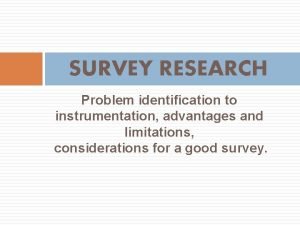Choosing a research approach What type of qualitative



















- Slides: 19

Choosing a research approach: What type of qualitative research should we use?

In both quantitative and qualitative analysis, we start with the unit of analysis: • Unit of analysis refers to what we are measuring or examining in our study. • It usually pertains to the level or system we are studying: individual, group, family, organization, or community. • We might also choose to examine language, communication, or documents (such as newspapers, case records, videos, etc).

Gall, Board, and Gall (1996 as cited in Rossman & Rallis, 2003, p. 91) have developed a guide for picking a unit of analysis Type of phenomena/units of analysis: 1) The individual and his/her experiences. What is she/her thinking or experiencing? 2) The group and its culture: What are the participants doing and what does it mean to them? 3) Language and communication patterns: What do the participants speak about? How do they communicate those meanings? What do symbols and signs mean to participants?

There are numerous types of qualitative research. Three primary types identified in your text are: • • Ethnographic studies Phenomenological studies Socio-communication studies Case studies

Ethnographic studies: • • Looks at cultural values, beliefs, and behaviors – culture includes any group of people (usually out of the mainstream of society) in which people identify. Members of the group have their own way of doing things and beliefs. They may even have their own language (this can include slang and/or technical terms) Culture can be defined as: “lifestyle practices of particular groups of people who are influenced by a learned patterns of values, beliefs, and cultural modalities” [practices] (Lum, 1996, p. 72). Increasingly, research that looks at how people interact with one another in organizations are also referred to as ethnographies. This is because most organizations or groups have unique values and ways of doing this due to the different rules and various personalities of the people in the organizations.

Ethnographic studies are conducted by: • Looking at social actions and interactions that take place in a setting • Looking at what these actions mean to the people in the setting when the action takes place. • Looking how actions are organized into social patterns. • Looking at what rules apply • How do these patterns compare with other actions in the setting or different settings.

In ethnography: • Researchers participate in the culture – but people studied know that they are interacting with a researcher. • The researcher stays in the setting for a long period of time. • Data collection includes observation, interviews, and content analysis.

Can you think of groups that may have their own culture?

Examples of cultural groups: • • • Ethnic populations Homeless people People with disabilities LGBT individuals Hip Hop Culture Nudists

Major assumptions associated with ethnographic as well as other types of qualitative research is: • That much previous research has focused exclusively on privileged members of the dominant culture – primarily white males. • The ethnicity, gender, and social class of the researcher (or standpoint) influences how he/she conducts research and how data is interpreted. • Therefore research should be conducted by diverse people and researchers should strive to understand the lives and perspectives of people who have been under-represented in previous research. • Rossman & Rollis refers to these assumptions as “critical and postmodernist” perspectives.

Phenomenology • Focuses on the “lived experience” of a small number of people. • Explores the meaning of people’s lives based on their own perceptions. • Purpose of phenomenology is to describe people’s lives, interpret their experiences, and for the researcher and the participant to reflect (think about) the topic and the process.

Data collection in Phenomenology: • In-depth interviews are conducted by the researcher. • Looks at what people experience and what it means to them. • Looks at the stories people construct about their own lives.

How is phenomenology conducted: Rossman & Rolllis recommend three interviews with each research participant in order to: 1) Examine the interviewee’s life history. 2) Look at a specific experience of the interviewee that the researcher is interested in examining. 3) Draws both previous interviews together in a “reflective” (i. e. thoughtful discussion about the meaning of the interviewee’s experience. )

Two types of research related to phenomenology are: • Life history (also called biography or oral history). It involves a long interview (and sometimes observation) with an individual about his or her life and what he or she has experienced and what it means to them. • Narrative research. It focuses on people’s stories about their own lives. The research looks s at the meaning placed on specific events/experiences by the interviewee or specific life patterns. (There is a “narrative approach” to psychotherapy in which social workers help people identify these patterns).

Socio-communication Studies • Looks for meaning in words, gestures, and signs. • Looks at words and actions people use to communicate in different groups and settings. • Looks at the communication-related meaning of other signs in the settings. • Looks at how age, ethnicity, social class, etc. shape language and how people communicate with one another. • This type of research is also call symbolic interactionism.

Signs can include: • Words, Objects, Pictures • Signs generally have a (symbolic) meaning beyond the obvious. • Examples include: Gang graffiti “Cause” bracelets Use of slang or technical terms

Data Collection for Sociocommunication studies: • Tape and vide-recording of speech; analysis of signs or symbols. • Examines the meaning of words, gestures, and signs people use to communicate. • Looks at how communication is use to discriminate against or marginalize people, maintain power, or sustain systems.

Case studies • • Overall approach to research. Uses interviews, observation, and content analysis. In-depth, detailed examination of a single example (event, process, organization, group, or individual. ) Look for things that make that example unique or similar to other explorations of that event, situation, or individuals. ****Focus is on that specific case. Use thick description, including details, facts, documentation of people’s perceptions and experiences. May involve a combination of quantitative and qualitative methods. Sometimes used to evaluate either: 1) A description of what happens in the context of a social work intervention. 2) Why an intervention was effective or not effective?

On Thursday: • We will listen to a phenomenological interview. • Working in groups, you will identify a research topic you want to know more about and write two research questions. • Conduct brief interviews with people in this class.
 Holistic perspective in qualitative research example
Holistic perspective in qualitative research example Features of qualitative research
Features of qualitative research Approaches to measuring performance
Approaches to measuring performance Defining performance and choosing a measurement approach
Defining performance and choosing a measurement approach Research paper appendices example
Research paper appendices example Types of research instruments
Types of research instruments Research qualitative or quantitative
Research qualitative or quantitative What is qualitative research
What is qualitative research Virtual circuit and datagram network
Virtual circuit and datagram network Cognitive approach vs behavioral approach
Cognitive approach vs behavioral approach Fine-grained screening
Fine-grained screening Multiple approach-avoidance
Multiple approach-avoidance Cognitive approach vs behavioral approach
Cognitive approach vs behavioral approach Research approach definition
Research approach definition Traditional development approach
Traditional development approach Tony wagner's seven survival skills
Tony wagner's seven survival skills Qualitative paper example
Qualitative paper example Data collection instruments in qualitative research
Data collection instruments in qualitative research What is methodological integrity
What is methodological integrity What is the sample size in qualitative research?
What is the sample size in qualitative research?





































